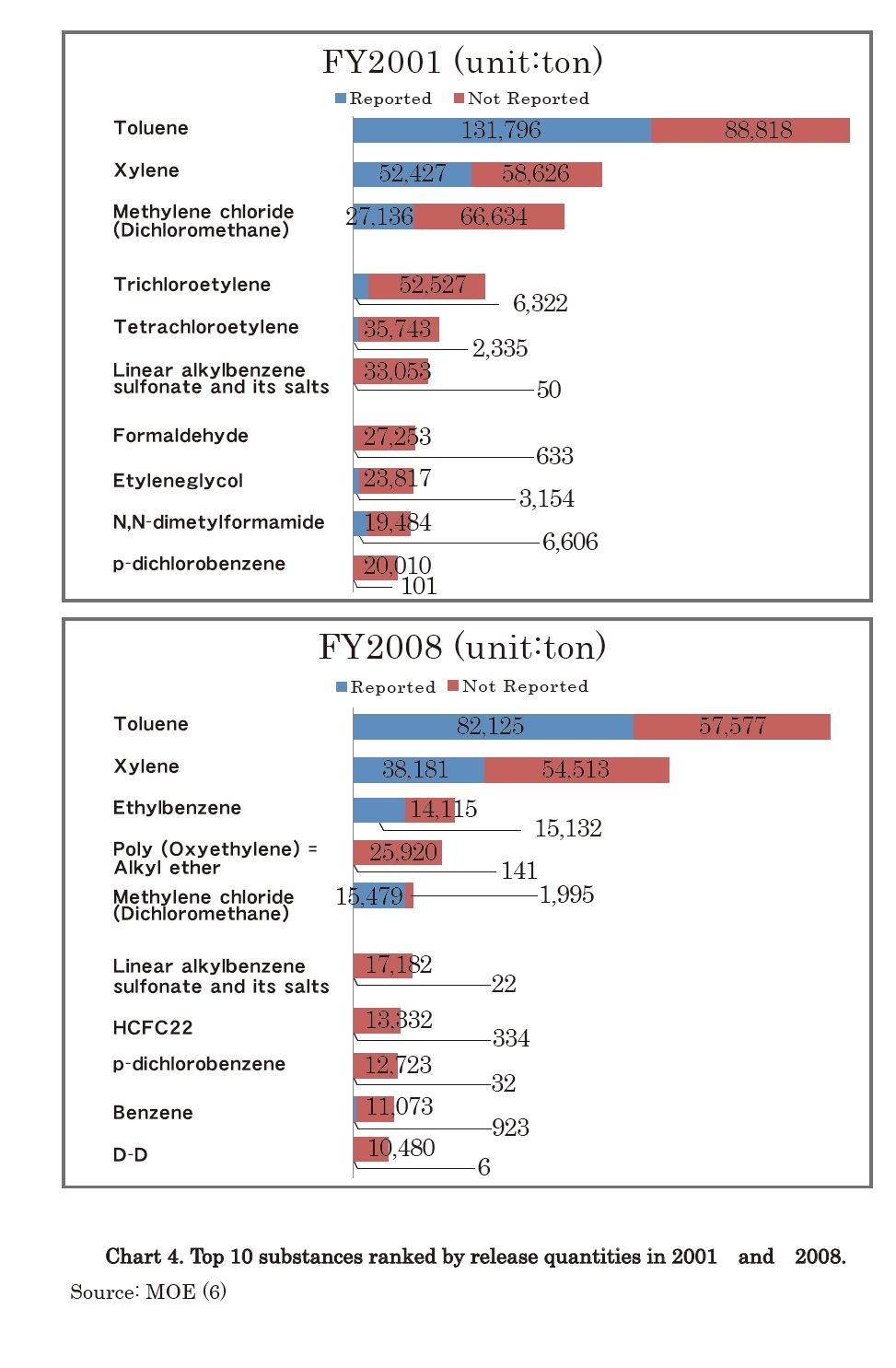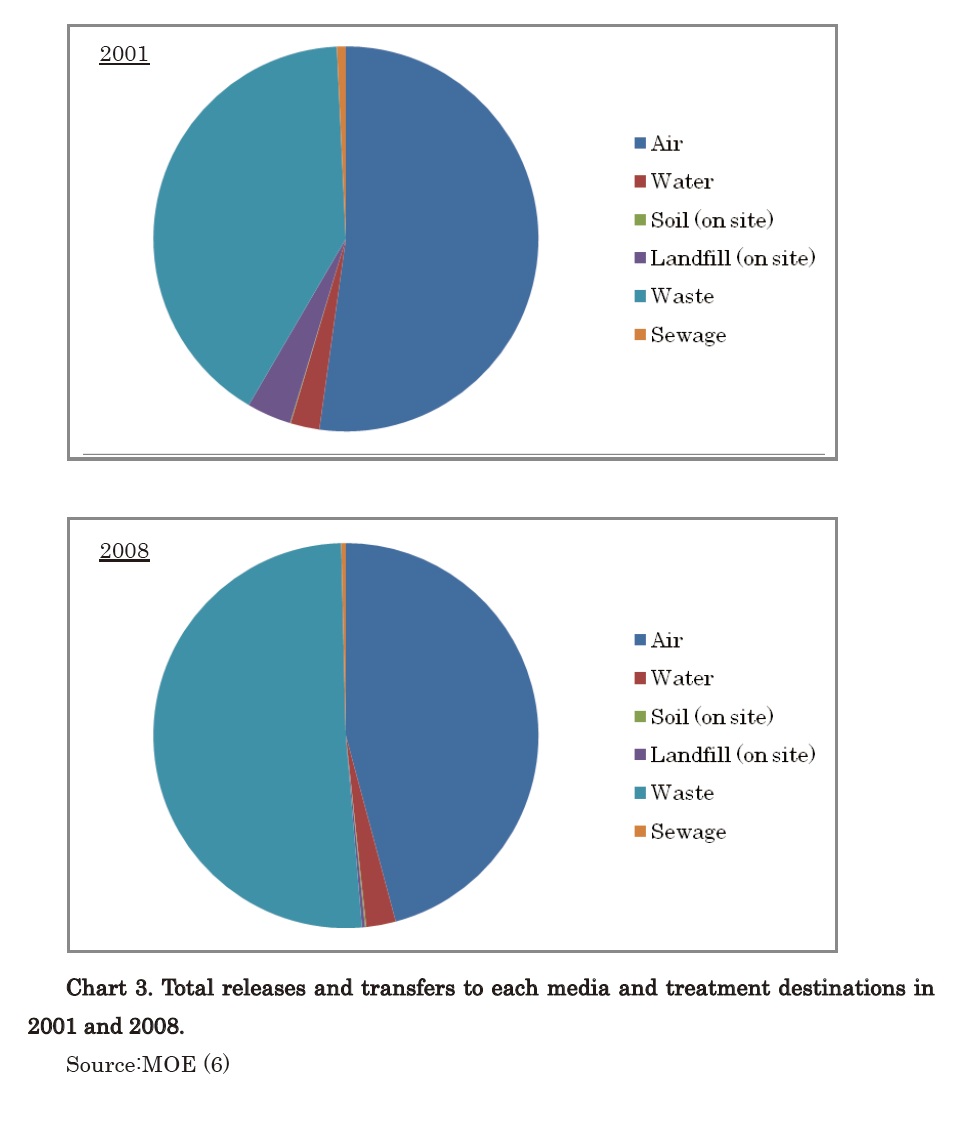| Overview of the First Yearfs PRTR Data (FY2001) According to the first set of PRTR data (FY2001 disclosed in March 2003), reported releases of chemical substances amounted to about 310,000 metric tonnes, reported transfers were 220,000 tons, and the gEstimated Releases Outside Notificationh totaled 580,000 tones, making a total of 1.1 million tons. Of the releases, 280,000 tonnes (89%) were released into air, 13,000 tonnes (4%) into water, and 20,000 tonnes (6%) were sent to landfill. Transfers consisted of 220,000 tonnes (98%) of wastes transferred outside of the reporting sites and 4,000 tonnes discharged to the sewerage system (see Chart 3).
 The first set of data for FY2001 revealed that approximately 90% of the total releases were into air. The top five substances (by quantity released) from reporting BOs and Estimated Release Outside Notification were toluene and xylene used as solvent for paints, dichloromethane for cleansing of metal surfaces in the chemical, plastic and metal product manufacturing industries, trichloroethylene used in the metal product and precision equipment manufacturing industries, trichloroethylene and tetrachloroethylene used in the dry-cleaning industry (See Chart 4). Toluene releases totalled 89,000 tonnes from Estimated Releases Outside Notification, and 220,000 tonnes were released into air in total. Xylene totalled 59,000 tonnes were from Estimated Releases Outside Notification, and 110,000 tonnes released into air in total as well. It was found that toluene and xylene are mainly released from solvents in paints for domestic use, in exhaust gases from cars and some small BOs without reporting requirements. The large amount of tetrachloroethylene was considered to be released because of its use as a cleaning agent by small dry-cleaning shops. The PRTR data showed that the substance with the sixth highest releases was linear alkylbenzene sulfonate (LAS), used as a major component of certain detergents. Some 330,000 tonnes was released, mostly from households. The seventh largest substance was formaldehyde with the release of 270,000 tonnes from mobile sources. These results may explain why Japanese citizens have been suffering from sick house and school syndrome and Multiple Chemical Sensitivity (MCS) since the late 1990s. Huge quantities of chemical substances are released into air, especially from Estimated Releases Outside Notification (4). The data made it clear which substances should be tackled: para-dichlorobenzene released from households and formaldehyde in the exhaust gases of cars. Para-dichlorobenzene, sold under the trade name of gParazoruh was the tenth highest for releases, with 20,000 tonnes of the toxic substance released from closets and storage areas for clothes in households (7). In the 1990s, para-dichlorobenzene contained a small amount of dioxin. Japanese citizens had not been informed about this problem. But now the PRTR data gave citizens an opportunity to review their lifestyles.
The industrial sectors reporting the largest releases are importing machine manufacturing, the chemical industry, plastic products manufacturers and the publishing and printing industries. These sectors report releases in the order of 20,000 to 55,000 tons.
6) Method of estimation for Estimated Releases Outside Notification can be downloaded from MOEfs website. http://www.env.go.jp/chemi/prtr/result/todokedegai_siryo.htmliJapanese onlyj PRTR data for each fiscal year can be downloaded from the websites below. http://www.env.go.jp/council/05hoken/y055-07.html Japanese only
|
